Household Food Waste: A Case Study in Southern Italy
Abstract
1. Introduction
2. Materials and Method
2.1. Questionnaire Design and Data Collection
2.2. Self-Organising Map (SOM) Construction and Validation
2.3. Clustering
3. Results
3.1. Descriptive Statistics
3.2. Profiling Consumer Segments
4. Discussion
5. Conclusions
Author Contributions
Funding
Acknowledgments
Conflicts of Interest
Appendix A
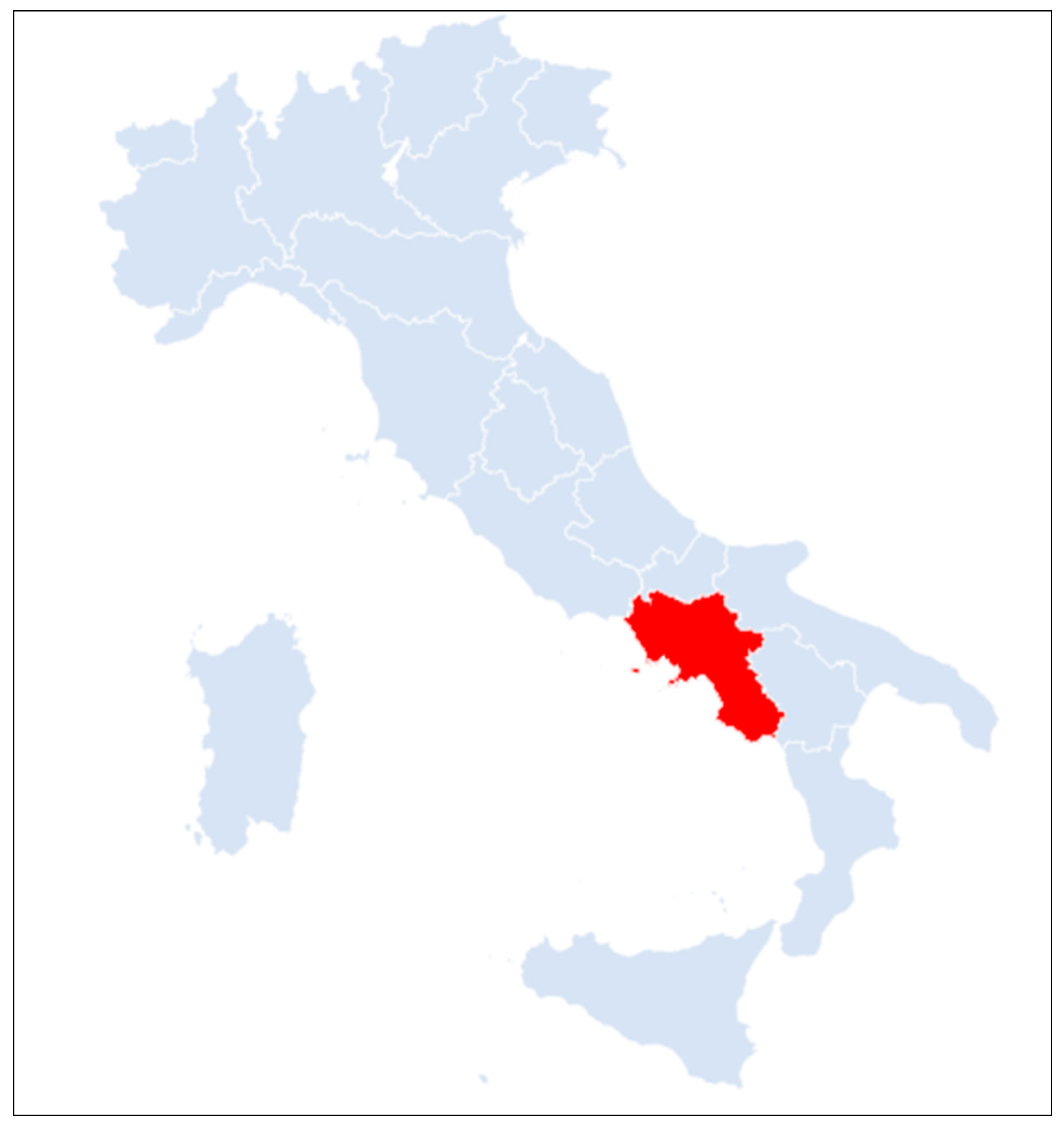
References
- United Nations. General Assembly Resolution A/RES/70/1. Transforming Our World, the 2030 Agenda for Sustainable Development. Available online: https://www.un.org/sustainabledevelopment/sustainable-consumption-production/ (accessed on 18 September 2017).
- European Commission. Communication from the Commission to the European Parliament, the Council, the European Economic and Social Committee and the Committee of the Regions. Towards a Circular Economy: A Zero Waste Programme for Europe. 2014. Available online: https://eur-lex.europa.eu/resource.html?uri=cellar:aa88c66d-4553-11e4-a0cb01aa75ed71a1.0022.03/DOC_1&format=PDF (accessed on 10 July 2016).
- Stenmarck, Â.; Jensen, C.; Quested, T.; Moates, G. Estimates of European Food Waste Levels; IVL Swedish Environmental Research Institute: Stockholm, Sweden, 2016; Available online: http://www.eu-fusions.org (accessed on 10 March 2019).
- Canali, M.; Amani, P.; Aramyan, L.; Gheoldus, M.; Moates, G.; Östergren, K.; Silvennoinen, K.; Waldron, K.; Vittuari, M. Food waste drivers in Europe, from identification to possible interventions. Sustainability 2017, 9, 37. [Google Scholar] [CrossRef]
- Bos-Brouwers HE, J.; Soethoudt, J.M.; Canali, M.; Östergren, K.; Amani, P.; Aramyan, L.; O’Connor, C. Drivers of Current Food Waste Generation, Threats of Future Increase and Opportunities for Reduction; FUSIONS N FP7-KBBE-2012-6-311972; The Swedish Institute for Food and Biotechnology: Göteborg, Sweden, 2014. [Google Scholar]
- Aschemann-Witzel, J.; De Hooge, I.E.; Almli, V.L.; Oostindjer, M. Fine-tuning the fight against food waste. J. Macromarketing 2018, 38, 168–184. [Google Scholar] [CrossRef]
- Schanes, K.; Dobernig, K.; Gözet, B. Food waste matters-A systematic review of household food waste practices and their policy implications. J. Clean. Prod. 2018, 182, 978–991. [Google Scholar] [CrossRef]
- Stancu, V.; Haugaard, P.; Lähteenmäki, L. Determinants of consumer food waste behaviour: Two routes to food waste. Appetite 2016, 96, 7–17. [Google Scholar] [CrossRef] [PubMed]
- Qi, D.; Roe, B.E. Household food waste: Multivariate regression and principal components analyses of awareness and attitudes among US consumers. PLoS ONE 2016, 1, e0159250. [Google Scholar] [CrossRef] [PubMed]
- Bravi, L.; Francioni, B.; Murmura, F.; Savelli, E. Factors affecting household food waste among young consumers and actions to prevent it. A comparison among UK, Spain and Italy. Resour. Conserv. Recycl. 2020, 153, 104586. [Google Scholar] [CrossRef]
- Mondéjar-Jiménez, J.A.; Ferrari, G.; Secondi, L.; Principato, L. From the table to waste: An exploratory study on behaviour towards food waste of Spanish and Italian youths. J. Clean. Prod. 2016, 138, 8–18. [Google Scholar] [CrossRef]
- Principato, L.; Secondi, L.; Pratesi, C.A. Reducing food waste: an investigation on the behaviour of Italian youths. Br. Food J. 2015, 117, 731–748. [Google Scholar] [CrossRef]
- Melbye, E.L.; Onozaka, Y.; Hansen, H. Throwing it all away: exploring affluent consumers’ attitudes toward wasting edible food. J. Food Prod. Mark. 2017, 23, 416–429. [Google Scholar] [CrossRef]
- Priefer, C.; Jörissen, J.; Bräutigam, K.-R. Food waste prevention in Europe—A cause-driven approach to identify the most relevant leverage points for action. Resour. Conserv. Recycl. 2016, 109, 155–165. [Google Scholar] [CrossRef]
- Di Talia, E.; Simeone, M.; Scarpato, D. Consumer behaviour types in household food waste. J. Clean. Prod. 2019, 214, 166–172. [Google Scholar] [CrossRef]
- Stefan, V.; Van Herpen, E.; Tudoran, A.A.; Lähteenmäki, L. Avoiding food waste by Romanian consumers: The importance of planning and shopping routines. Food Qual. Prefer. 2013, 28, 375–381. [Google Scholar] [CrossRef]
- Secondi, L.; Principato, L.; Laureti, T. Household food waste behaviour in EU-27 countries: A multilevel analysis. Food Policy 2015, 56, 25–40. [Google Scholar] [CrossRef]
- Cecere, G.; Mancinelli, S.; Mazzanti, M. Waste prevention and social preferences: the role of intrinsic and extrinsic motivations. Ecol. Econ. 2014, 107, 163–176. [Google Scholar] [CrossRef]
- Setti, M.; Banchelli, F.; Falasconi, L.; Segrè, A.; Vittuari, M. Consumers’ food cycle and household waste. When behaviors matter. J. Clean. Prod. 2018, 185, 694–706. [Google Scholar] [CrossRef]
- Neff, R.A.; Spiker, M.L.; Truant, P.L. Wasted food: US consumers’ reported awareness, attitudes, and behaviors. PLoS ONE 2015, 10, e0127881. [Google Scholar] [CrossRef]
- Quested, T.E.; Marsh, E.; Stunell, D.; Parry, A.D. Spaghetti soup: The complex world of food waste behaviours. Resour. Conserv. Recycl. 2013, 79, 43–51. [Google Scholar] [CrossRef]
- Riverso, R.; Amato, M.; La Barbera, F. The effect of food waste habit on future intention to reduce household food waste. Qual. Access Success 2017, 18, 369–375. [Google Scholar]
- Visschers, V.H.; Wickli, N.; Siegrist, M. Sorting out food waste behaviour: A survey on the motivators and barriers of self-reported amounts of food waste in households. J. Environ. Psychol. 2016, 45, 66–78. [Google Scholar] [CrossRef]
- Graham-Rowe, E.; Jessop, D.C.; Sparks, P. Predicting household food waste reduction using an extended theory of planned behaviour. Resour. Conserv. Recycl. 2015, 101, 194–202. [Google Scholar] [CrossRef]
- Parizeau, K.; Von Massow, M.; Martin, R. Household-level dynamics of food waste production and related beliefs, attitudes, and behaviours in Guelph, Ontario. Waste Manag. 2015, 35, 207–217. [Google Scholar] [CrossRef] [PubMed]
- Williams, H.; Wikström, F.; Otterbring, T.; Löfgren, M.; Gustafsson, A. Reasons for household food waste with special attention to packaging. J. Clean. Prod. 2012, 24, 141–148. [Google Scholar] [CrossRef]
- Aschemann-Witzel, J.; De Hooge, I.; Amani, P.; Bech-Larsen, T.; Oostindjer, M. Consumer-related food waste: Causes and potential for action. Sustainability 2015, 7, 6457–6477. [Google Scholar] [CrossRef]
- Falasconi, L.; Cicatiello, C.; Franco, S.; Segrè, A.; Setti, M.; Vittuari, M. Such a shame! A study on self-perception of household food waste. Sustainability 2019, 11, 270. [Google Scholar] [CrossRef]
- Gaiani, S.; Caldeira, S.; Adorno, V.; Segrè, A.; Vittuari, M. Food wasters: Profiling consumers’ attitude to waste food in Italy. Waste Manag. 2018, 72, 17–24. [Google Scholar] [CrossRef] [PubMed]
- MIPAF-CREA, 2019. L’osservatorio Sulle Eccedenze, Sui Recuperi e Sugli Sprechi Alimentari Ricognizione Delle Misure in Italia e Proposte di Sviluppo. Available online: http://www.crea.gov.it/documents/59764/0/Osservatorio+CREA+O-ERSA+WEB.pdf/c93f0266-e5f7-e2f3-e581-32797328bb3b?t=1559138880594. (accessed on 16 September 2019).
- Grunert, K.G.; Brunsø, K.; Bredahl, L.; Bech, A.C. Food-related lifestyle: A segmentation approach to European food consumers. In Food, People and Society; Springer: Berlin/Heidelberg, Germany, 2001; pp. 211–230. [Google Scholar]
- Italian National Institute of Statistics. Official Data on Resident Population in the Italian Municipalities. Available online: https://ugeo.urbistat.com/AdminStat/it/it/demografia/dati-sintesi/campania/15/2 (accessed on 8 January 2020).
- Wehrens, R.; Wehrens, M.R. Package ‘Kohonen’. Available online: https://mran.microsoft.com/snapshot/2014-11-18/web/packages/kohonen/kohonen.pdf (accessed on 1 July 2019).
- Kollias, S.; Stafylopatis, A.; Duch, W.; Oja, E. Artificial Neural Networks—ICANN 2006. In Proceedings of the 16th International Conference, Athens, Greece, 10–14 September 2006; Springer: Berlin/Heidelberg, Germany. [Google Scholar]
- James, G.; Witten, D.; Hastie, T.; Tibshirani, R. An Introduction to Statistical Learning with Applications in R; Springer: New York, NY, USA, 2013. [Google Scholar]
- Alpaydin. E. Introduction to Machine Learning, 3rd ed.; The MIT Press: Cambridge, MA, USA, 2014. [Google Scholar]
- Romesburg. C. Cluster Analysis for Researchers; Lulu Press: Morrisville, NC, USA, 2004. [Google Scholar]
- Caliński, T.; Harabasz, J. A dendrite method for cluster analysis. Commun. Stat. Theory Methods 1974, 3, 1–27. [Google Scholar] [CrossRef]
- Giordano, C.; Alboni, F.; Falasconi, L. Quantities, Determinants, and Awareness of Households’ Food Waste in Italy: A Comparison between Diary and Questionnaires Quantities’. Sustainability 2019, 11, 3381. [Google Scholar] [CrossRef]
- Davies, A. Sharecity Typologies of Food Sharing. In Sharecity e Sustainability of City-Based Food Sharing; Working Paper 1. Trinity College Dublin: Dublin, Ireland, 2016; Available online: http://sharecity.ie/wp-content/uploads/2016/03/SHARECITY-TYPOLOGIES-OFFOOD-SHARING_WP1.pdf (accessed on 9 September 2019).
- Michelini, L.; Principato, L.; Iasevoli, G. Understanding food sharing models to tackle sustainability challenges. Ecol. Econ. 2018, 145, 205–217. [Google Scholar] [CrossRef]
- Jones, H. Tech Innovations That Could Reduce Food Waste. The Guardian. Available online: https://www.theguardian.com/business/2016/jul/14/tech-innovations-that-could-reduce-foodwaste (accessed on 9 September 2019).
- Young, W.; Russell, S.V.; Robinson, C.A.; Barkemeyer, R. Can social media be a tool for reducing consumers’ food waste? A behaviour change experiment by a UK retailer. Resour. Conserv. Recycl. 2017, 117, 195–203. [Google Scholar] [CrossRef]
- Newsome, R.; Balestrini, C.G.; Baum, M.D.; Corby, J.; Fisher, W.; Goodburn, K.; Labuza, T.P.; Prince, G.; Thesmar, H.S.; Yiannas, F. Applications and Perceptions of Date Labeling of Food. Compr. Rev. Food Sci. Food Saf. 2014, 13, 745–769. [Google Scholar] [CrossRef]
- Wikström, F.; Verghese, K.; Auras, R.; Olsson, A.; Williams, H.; Wever, R.; Grönman, K.; Pettersen, M.K.; Møller, H.; Soukka, R. Packaging strategies that save food: A research agenda for 2030. J. Ind. Ecol. 2019, 23, 532–540. [Google Scholar] [CrossRef]
- Aschemann-Witzel, J.; Otterbring, T.; De Hooge, I.E.; Normann, A.; Rohm, H.; Almli, V.L.; Oostindjer, M. The who, where and why of choosing suboptimal foods: Consequences for tackling food waste in store. J. Clean. Prod. 2019, 236, 117596. [Google Scholar] [CrossRef]
- World Resources Institute. Reducing Food Loss and Waste: Setting a Global Action Agenda. Available online: https://www.wri.org/publication/reducing-food-loss-and-waste-setting-global-action-agenda (accessed on 10 June 2019).
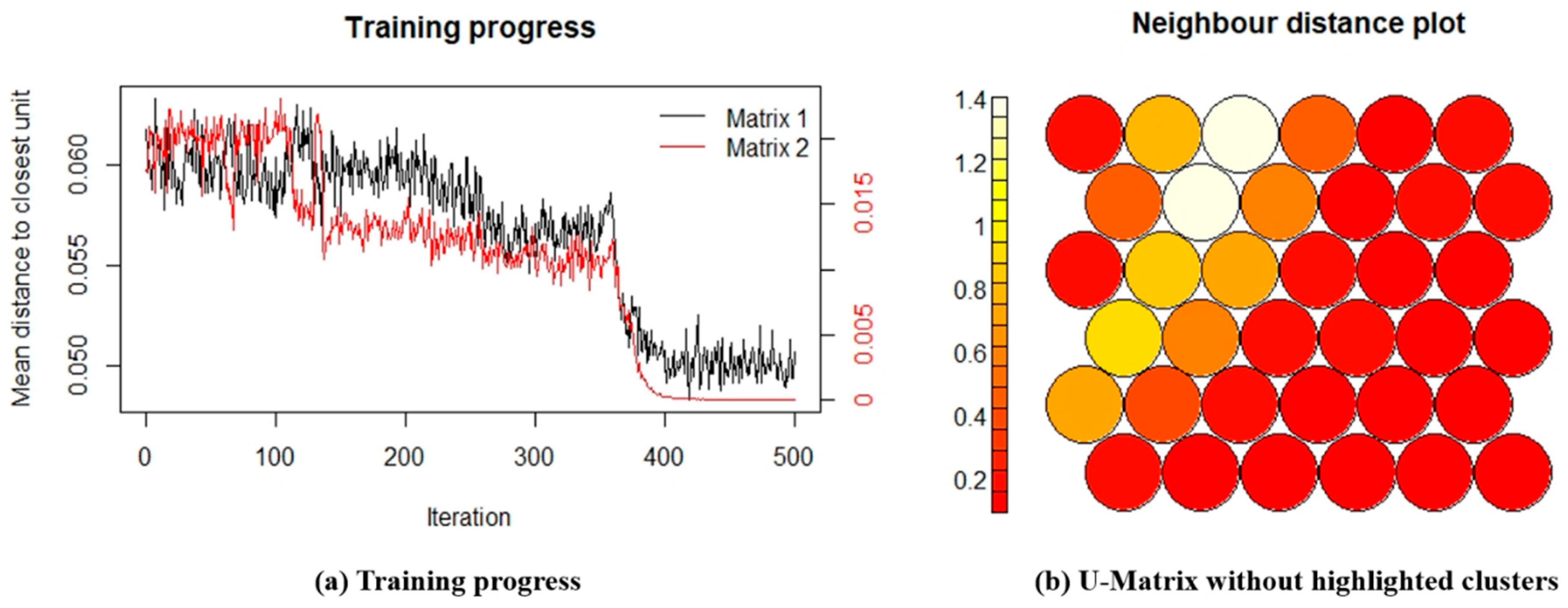
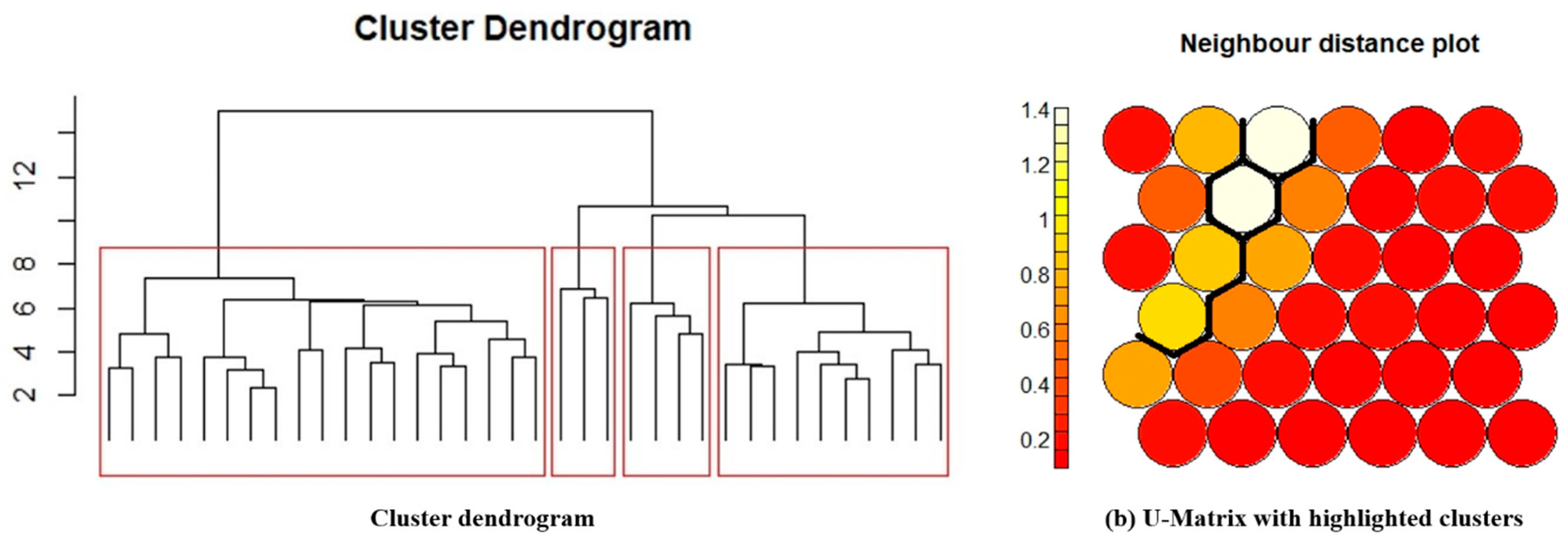
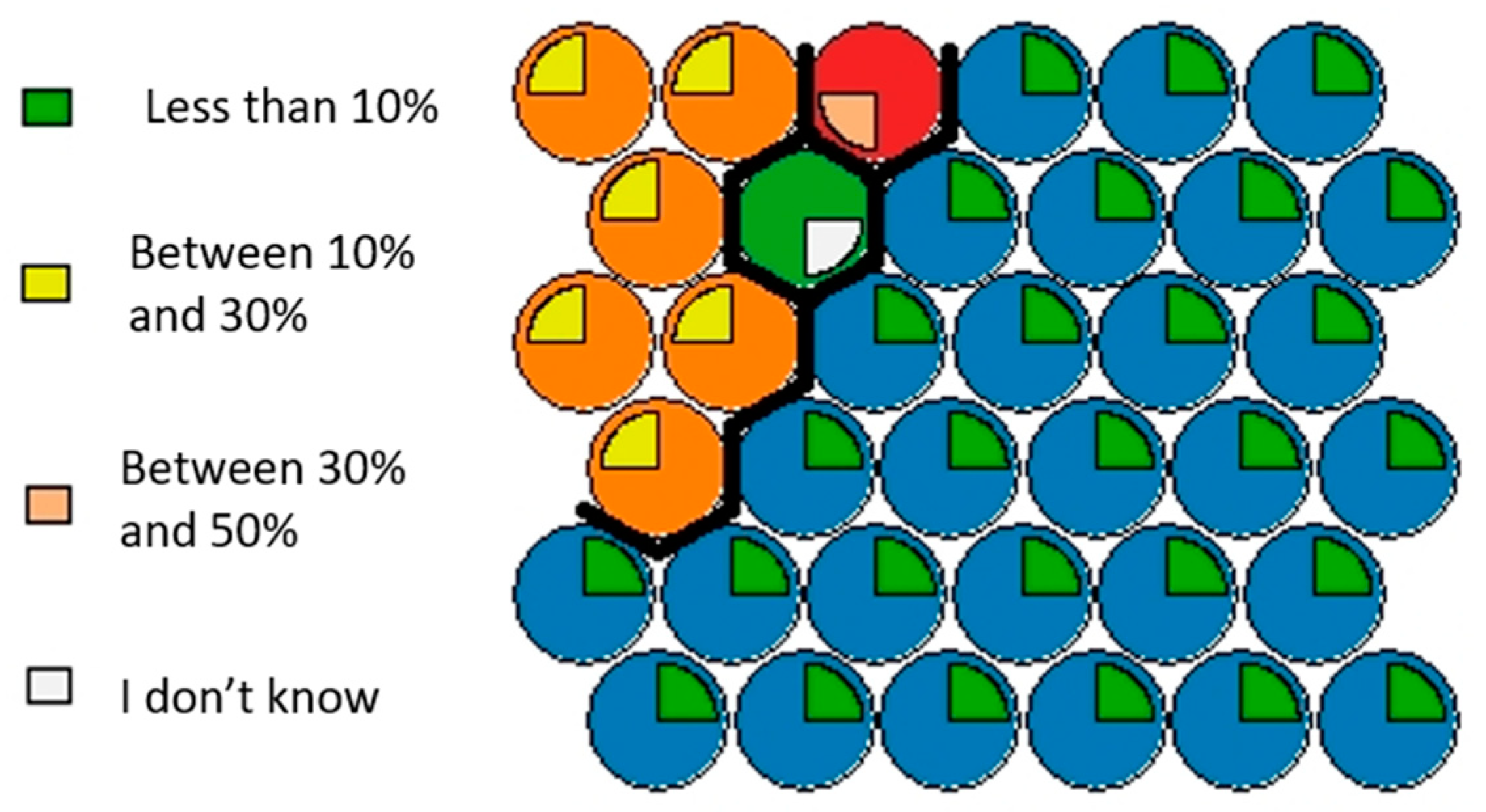
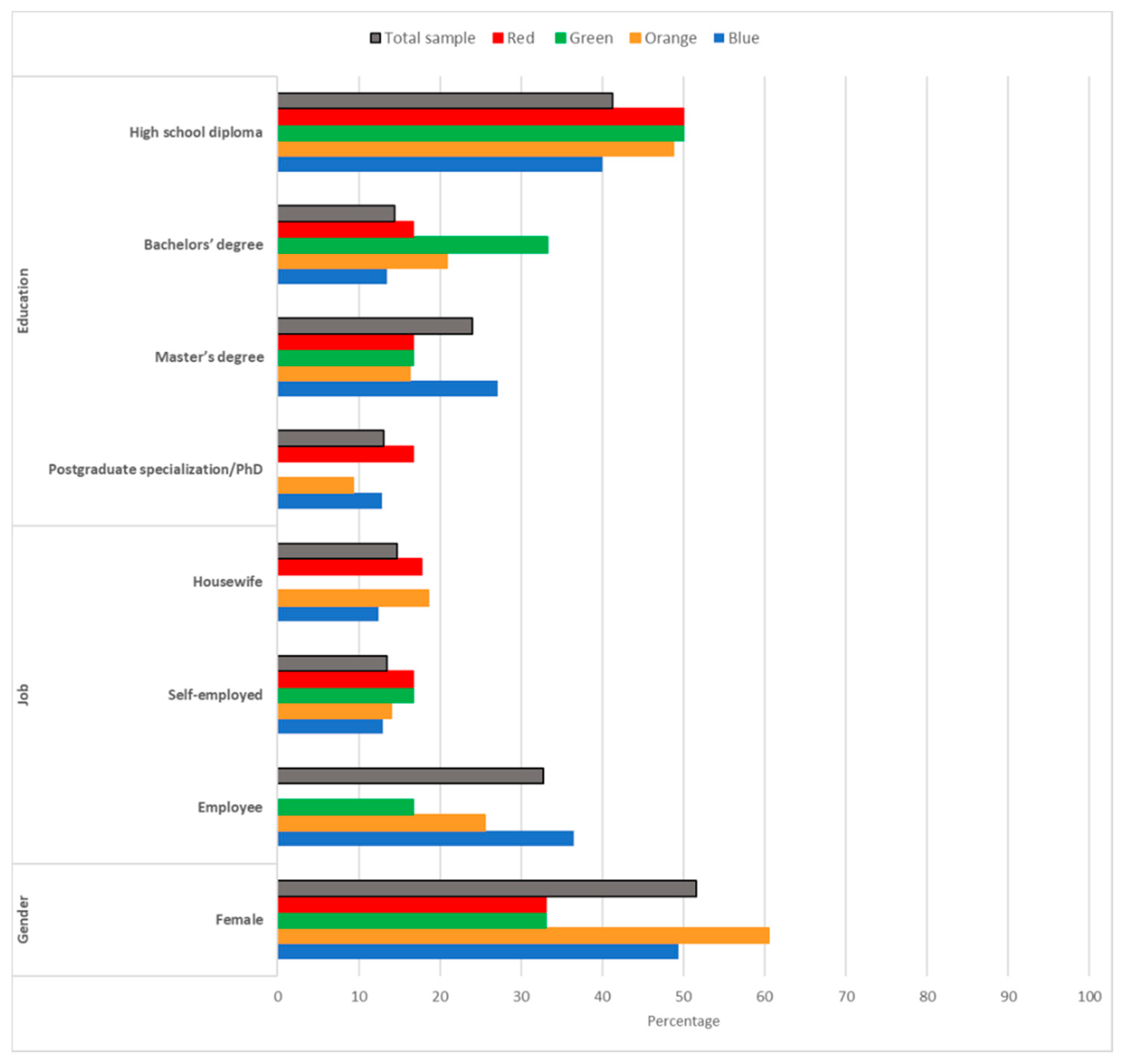
| Duda–Hart | Calinski–Harabasz | ||
|---|---|---|---|
| Number of clusters | Je(2)/Je(1) | Pseudo-T-squared | Pseudo-F |
| 1 | 0.8065 | 8.16 | |
| 2 | 0.815 | 3.41 | |
| 3 | 0.6112 | 3.18 | 6.45 |
| 4 | 0.8607 | 2.75 | 6.57 |
| 5 | 0.8563 | 2.18 | 5.79 |
| 6 | 0.4691 | 1.13 | 5.17 |
| 7 | 0.7402 | 2.81 | 4.9 |
| 8 | 0.815 | 2.04 | 4.63 |
| Blue | Orange | Green | Red | Total Sample | |
|---|---|---|---|---|---|
| Motivation that drives food waste behaviour (α = 0.687) | |||||
| Food has expired or gone bad | 3.68 | 3.60 | 4.66 | 3.80 | 3.77 |
| I bought/cooked too much food | 2.28 | 2.53 | 2.83 | 2.33 | 2.34 |
| The food is about to expire | 2.14 | 2.30 | 2.50 | 2.16 | 2.18 |
| I didn’t keep the food well and I worry that it may have gone bad | 3.10 | 3.34 | 4.33 | 2.50 | 3.16 |
| I have prepared/bought food that I or my family do not like | 1.93 | 2.04 | 2.83 | 2.00 | 1.98 |
| Food-related behaviour (α = 0.712) | |||||
| I like shopping for food | 3,12 | 3,30 | 3,52 | 3,22 | 3.29 |
| Shopping for food bores me | 2.23 | 2.04 | 1.83 | 3.16 | 2.21 |
| Shopping for food is like a game to me | 2.52 | 3.02 | 2.66 | 3.00 | 2.63 |
| Before I do a large amount of food shopping, I always make a list | 3.37 | 2.93 | 3.66 | 2.66 | 3.33 |
| I usually purchase food that I did not include in the shopping list | 3.20 | 3.20 | 4.16 | 3.66 | 3.24 |
| I usually buy larger amounts of food when supermarkets offer good value for money | 3.31 | 3.67 | 3.66 | 3.33 | 3.37 |
| I usually decide what to buy only when I am at the supermarket | 2.23 | 2.20 | 2.33 | 2.66 | 2.16 |
| I buy and eat only products that are familiar to me | 3.30 | 3.27 | 2.83 | 4.00 | 3.31 |
| I like to try new foods that I have never tasted | 2.95 | 2.97 | 2.16 | 3.16 | 2.92 |
| For me, the freshness of food products is very important | 4.50 | 4.53 | 4.50 | 4.83 | 4.49 |
| I prefer to buy fresh meat and vegetables rather than prepackaged | 4.19 | 4.23 | 3.66 | 3.83 | 4.24 |
| I always check the expiration date on the label | 4.23 | 4.16 | 4.50 | 4.66 | 4.24 |
| I always look for the product with the best value for money | 3.94 | 4.13 | 3.83 | 3.50 | 3.96 |
| I always compare product prices before buying them | 3.64 | 3.93 | 3.83 | 3.50 | 3.72 |
| I usually keep and reuse leftovers | 3.65 | 3.55 | 2.66 | 3.00 | 3.59 |
| Food waste concerns (α = 0.910) | |||||
| Waste of environmental resources (water, energy, soil, etc.) | 4.41 | 4.16 | 4.00 | 4.16 | 4.32 |
| CO2 emissions increase due to the production and transport of food | 4.05 | 3.79 | 4.00 | 3.83 | 3.98 |
| Waste of economic resources for the purchase of food not consumed | 4.20 | 3.86 | 4.00 | 3.83 | 4.03 |
| Inequalities in food distribution among the world’s population | 4.24 | 3.95 | 3.83 | 3.66 | 4.18 |
| Loss of biodiversity and desertification linked to intensive food production | 4.02 | 3.97 | 4.00 | 3.16 | 4.01 |
| Waste of economic resources linked to policies for the disposal of food surpluses | 4.01 | 3.86 | 4.00 | 3.00 | 3.96 |
| Intention to reduce food waste (α = 0.625) | |||||
| I would like to reduce the amount of food wasted by programming my purchases better | 4.05 | 3.69 | 4.33 | 4.16 | 4.051 |
| I would like to reduce the amount of food wasted by paying more attention to the portions I prepare | 3.89 | 3.88 | 4.33 | 3.50 | 3.97 |
| Even if I wanted, it would be impossible for me to reduce the amount of food wasted on my family | 2.08 | 2.32 | 2.66 | 2.00 | 2.14 |
| I do not intend to change my habits | 2.10 | 2.04 | 2.33 | 1.16 | 2.07 |
| Motivation to prevent food waste (α = 0.755) | |||||
| Think about people who do not have enough food | 4.20 | 4.23 | 4.83 | 3.00 | 4.19 |
| The desire to efficiently manage my family spending | 4.23 | 4.23 | 4.50 | 2.83 | 4.20 |
| The thought of wasted natural resources (energy and water) in the production of wasted food | 4.18 | 3.86 | 4.33 | 2.66 | 4.08 |
| I could waste less food if… (α = 0.710) | |||||
| Smaller packages of food were available in stores | 3.70 | 3.86 | 4.00 | 2.33 | 3.77 |
| There was information on how to interpret the expiration date on the label correctly | 4.13 | 4.02 | 4.50 | 2.83 | 4.08 |
| There was more information on how to share or donate food | 4.23 | 4.21 | 4.83 | 3.00 | 4.21 |
© 2020 by the authors. Licensee MDPI, Basel, Switzerland. This article is an open access article distributed under the terms and conditions of the Creative Commons Attribution (CC BY) license (http://creativecommons.org/licenses/by/4.0/).
Share and Cite
Annunziata, A.; Agovino, M.; Ferraro, A.; Mariani, A. Household Food Waste: A Case Study in Southern Italy. Sustainability 2020, 12, 1495. https://doi.org/10.3390/su12041495
Annunziata A, Agovino M, Ferraro A, Mariani A. Household Food Waste: A Case Study in Southern Italy. Sustainability. 2020; 12(4):1495. https://doi.org/10.3390/su12041495
Chicago/Turabian StyleAnnunziata, Azzurra, Massimiliano Agovino, Aniello Ferraro, and Angela Mariani. 2020. "Household Food Waste: A Case Study in Southern Italy" Sustainability 12, no. 4: 1495. https://doi.org/10.3390/su12041495
APA StyleAnnunziata, A., Agovino, M., Ferraro, A., & Mariani, A. (2020). Household Food Waste: A Case Study in Southern Italy. Sustainability, 12(4), 1495. https://doi.org/10.3390/su12041495





